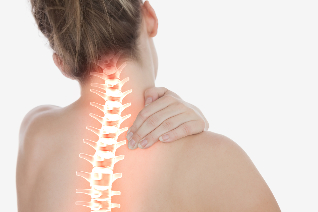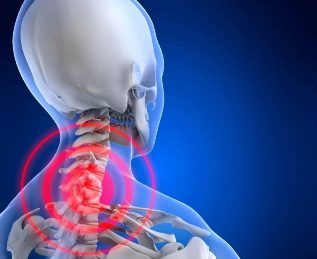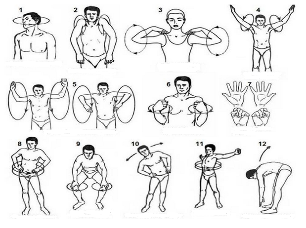Rare now not to be confronted with the manifestations of this widespread of the disease: according to statistics, approximately 60% of the population in the developed countries, to a different extent, suffer from the manifestations of the degenerative disc disease. The main causes of such a wide diffusion – sitting work and lack of motion of the modern man.

The osteochondrosis of the cervical spine (Osteohondroz) is specific of the defeat of the intervertebral discs, as a result of which will damage the discs, the vertebrae and the joints of the cervical region, there is a reduction of the height of the intervertebral discs. The disease progresses, if not treated, and can cause headaches, loss of the circulation of the blood and even hernia. As treating osteoporosis, the disease occurs because of a violation of mineral exchange, and, in consequence, the bones and joints become less strong.
The osteochondrosis can cause instability of the cervical spine (the symptoms and treatment are similar to those of with chondrosis, but they have a number of characteristics), which often is accompanied by a displacement of the vertebrae. This, in turn, accelerates the development of degenerative disc disease, the destruction of vertebral of the division.
The osteochondrosis of the cervical spine: the symptoms
In the early stages of the disease almost does not manifest itself the painful symptoms: you may feel discomfort in the neck after a great effort by a physicist, or a long seat in the tense posture, after a sudden movement or tilt of the head.
The main symptoms – headache, dizziness and lack of coordination, slight crunch to the movement of the head, general weakness; less frequently observed weakness of hands, numbness of the tongue and disorders in speech, difficulty breathing, vision, hearing, increased sweating, abnormally high levels of blood pressure. The main area of the nape of the neck, the neck, the collar area. In most cases, at the same time, you will observe several of the signs of the disease.
In general, the symptoms of osteochondrosis is not obvious, often masked by the use of pain medications. In this consists one of its pitfalls: the majority of symptoms are possible, and other pathologies, which complicates the diagnosis of degenerative disc disease cervical.
Dizziness when osteochondrosis cervical
This condition is not always clearly indicates the osteochondrosis of the cervical spine.
The vertigo may be the result of:
- the swelling in the average, or inner ear;
- spasms of the vessels of the brain;
- the violation of transmission of nerve impulses;
- problems with the vestibular apparatus;
- diseases of the cardiovascular system.
There are No clear criteria for the vertigo to osteochondrosis. However, there are variables of the system and non-systemic vertigo, have clear differences.
It is recommended to know the differences of the system and not the system vertigo, this will help to determine the causes of the unusual status:
- the system of dizziness is the sensation of circular movement, the objects around her or the body, which is the consequence of the breach of work balance, analyzers, and visual receptors in the joints, the muscles and the epidermis (the osteochondrosis of different etiology);
- no, the system the vertigo is the feeling of nausea, lightheadedness, unsure of status in the vertical position. When non-system dizziness, the sensation of circular rotation of the fault, and it's an important difference that is compared to the signs.
The person who feels the vertigo of one of the specified types, it should be examined by an experienced doctor, in the first place, neuropathologist, or (if there is any suspicion of disease of the ear, nose, and throat), otolaryngologist.
The reason for the emergency hospitalization, not correlated with osteochondrosis of the cervical spine, is the identification of the person who has (in addition to the dizziness) reasons such as:
- the paralysis of the facial muscles and the numbness of the part of the shoulder girdle;
- headache strong against the deterioration of well-being;
- lack of coordination of movements;
- the loss or extinction of the consciousness.
Headache when osteochondrosis cervical
It is one of the most common non-specific features of many diseases in humans. Headaches especially widespread in the population. It is difficult to determine the cause of the headaches, and, without more, associate with spinal cord injuries. Revealed about 14 different causes of headache in human beings.
The most common causes of headaches when you described for us of the pathology is:
- the spasms of the blood vessels of the brain;
- the crushing of the nerve roots;
- reflects the increase in the intracranial pressure.
Headache when osteochondrosis cervical cancer can be similar to the feeling in high blood pressure, angina, or stroke. Without more, the people of the middle ages and, normally, there is a risk of development of cerebrovascular accidents or heart attacks.
The sensation of pain may be paroxysmal, constant, vibrant, and forceful.
When the pathology is of the heart, the patients complain of discomfort in the chest, accompanied by a violation of the heart rhythm. Determine the cause can be only a qualified doctor. In case of headaches, in combination with nausea, dizziness, and retrosternal pains, necessarily do an electrocardiogram.
Pain osteochondrosis cervical
Not always the pain is located specifically in the area of the head and the nape of the neck. Known are the cases of different location of the pain.
The neck pain can radiate to the shoulder area and in different parts of the hand. The distinctive feature of these feelings is the surprise of the attacks, after sleep, sudden movements, unobtrusive man of tension, for example, when you laugh or sneeze. The pain related to osteochondrosis, if the process has not of chronic character, it generally disappears after a short space of time and combined with the creaking in the cervical vertebrae.
Without the prior of the survey should not remove the pain with the help of manipulative therapy (massage). In some cases, a clumsy manipulation can aggravate the pathology is, to break the innervation and lead to disability of the patient.
The intensity of the pain can be moderate or strong. Duration – as the short and the long run.
It has been observed that the osteochondrosis of cervical most often associated with the defeat in the sixth and seventh cervical vertebrae.
There are tests to determine the location of the focus of the pain impulse. The defeat in the field of the sixth vertebra is supplemented with pains in the thumb of the hand, and that the defeat at the field of the seventh vertebra is accompanied by pain sensations, on average, between the finger.
The blood pressure during the osteochondrosis of cervical
The relationship of osteochondrosis cervical alterations of the blood pressure a long time ago installed. The cervical vertebrae are important nerve endings and the blood vessels.
Are characteristic peaks of pressure during the day. Hypertension for a long time, is not a feature of this disease. Reflects the irritation of the nerve endings, and short-term spasms of the blood vessels cause the break of the daily dynamics of the hypertension.
A distinctive feature of the increased pressure of cervical spine osteochondrosis is a combination of the following symptoms:
- headache;
- the pain in the limbs and the chest;
- the reduction of the sensitivity in the area of the nuchal translucency thickness;
- the appearance of pressure peaks after the stress, muscle tension, long-term presence in an awkward position and other similar situations.
The sudden jumps HELL and the rapid deterioration of wellbeing are the basis for the treatment of the services of urgent medical aid.
The stage of development of the degenerative disc disease
In the development of the degenerative disease of the cervical disc are divided in 4 stages. But it is very conditional division, as well as most of the symptoms of the disease may occur in other pathologies.
The first phase (doklinicheskaya)
In the initial phase of the symptoms are mild and often attributed to stress or other diseases. Feel the difference of stiffness in the neck, pain with sudden movement or slopes. In this phase, the possible to get rid of the headwaters of the osteochondrosis with the help of gymnastics a medicinal or simply move around more, adjust the power.
The second stage of the
The pains are intensified, they become permanent, when the closed curves or slopes are already strong. Appear severe headaches, the patient begins to tire quickly, it becomes diffuse, periodically numb areas of the person.
The third stage
The formation of a herniated disc often causes dizziness, weakness of the arms, pain shooting in the nape of the neck and hands, constantly feels on the shoulders.
Fourth stage
Finally the discs of the spine are broken, and are replaced by connective tissue. The nerves zaselyalsya, which leads to difficulty in movement, severe pain, and the strengthening of vertigo, noise appears in the ears.
Causes and risk factors
Interestingly, the possibility of developing the degenerative disc disease of the man to obey one of their evolutionary advantages of – the upright posture: vertebrae, pressed together, and with age, the connective tissue is degraded. As a result, people of age is almost inevitable. But there are many factors that contribute to the more early and intensive the development of the degenerative disc disease cervical:
- In the first place, it is the sedentary lifestyle and sedentary lifestyle, has often been in modern life (office employees, drivers and other "sitting" of the specialty, tv, long hours behind a computer), lack of exercise, a physical
- Tense, postures unnatural in the work process: for example, behind a team of people often leans forward, taking in the tense posture
- The opposite reason – too high, so unusual for this person for the load; but in the area of risk – even trained athletes, for example, weight lifters;
- The reasons for the violation of the natural posture of man: uncomfortable shoes, especially high heels, bad posture during sleep, flat feet, rheumatism, scoliosis;
- The excess of weight, which is often caused by a bad power supply
- Frequent stress, the strong permanent tension of exhaustion
- Local hypothermia
That dangerous neck of the osteochondrosis
In the neck it focuses a lot vital of the vessels, the arteries, the capillaries, so that any infringement there may have unpleasant consequences, including hypoxia, hypertension, vascular dystonia.

The osteochondrosis of cervical affects the segments of the spine, direct the work of the shoulders, and elbow joints, the thyroid, the palms of the hands and of the other organs. To the osteochondrosis, and if left untreated, there is a high probability of crushing of the nerves, pressure of the vessels, which inevitably has an impact on the work of other bodies.
How to cure osteochondrosis cervical
Real, stable success in the treatment of degenerative disc disease, cervical can reach only a global approach that includes medication, massage of nuchal translucency, treatment gym, therapy. In particular run cases may require a surgical intervention.
We advise you to resort to self-medication in the first place, by the fact that the symptoms of degenerative disc disease can mean very different of the disease: not selected of medications do not help in treatment, they can still cause damage.
Extraction of sharp pain
The osteochondrosis, especially in the stages eugen end, d, accompanied by severe pain, therefore, the first task of the physician is to relieve their suffering. He will prescribe pain relievers, anti-inflammatory, vitamins, chondroprotectors for the recovery of cartilage tissue, medications to improve circulation and reduce muscle spasm.
Gymnastics osteochondrosis cervical
The easiest and most accessible, including the home, the form – gymnastics. If this is effective enough to, as it strengthens the muscles of the neck, restores the circulation in the sections damaged, compensate for the lack of movement in daily life. Curative physical education can be supplemented with swimming, Aqua.
Therapeutic exercise – the easiest and most accessible type of treatment of osteochondrosis of cervical and, at the same time, efficient enough to. The treatment of physical education can be done in the home. The osteochondrosis of the intensity of the occupations does not play a decisive role, need only your regularity. In the first place, the physical education is designed to strengthen the muscles of the neck, which replace the lack of functionality of the spine and help keep the weakening of the vertebrae.

To strengthen the muscles of the neck are recommended daily activities. Can be very simple, composed of curves and slopes to the head in the parties different and more complex that include the help of a strap to the neck muscles on the side of the hand. Can be done at home or at work. For example, if the work is sedentary, it is useful to make this type of exercises after an hour of laying on the table or on the monitor.
Physiotherapy
Correct and constant application of methods of physiotherapy contributes to the improvement of the circulation in the sections damaged, the reduction of the inflammation and the pain, reduces the process of ossification.
The osteochondrosis of cervical use, electrophoresis, magnetic therapy, laser therapy, shock wave wave therapy, treatment, tub and shower, mud therapy and other methods.
The massage of the neck to the osteochondrosis of the cervical spine
The osteochondrosis massage can be very effective: it improves circulation, reduces the probability of suffering from spasms due to the reduction in the muscle tone, eases the symptoms of pain and improves the overall health of the patient.
But the massage and the quiroprctica should be applied with care, since improper and a serious impact on the sick parts of the body can only do harm.
The surgical treatment
Especially in the run of cases, does not rule out even the surgery: narrowing of the intestinal lumen to the spinal column, the formation of a hernia of the intervertebral discs, when the spondylolisthesis.
The decision on the need for and mode of intervention, surgical decision the surgeon, he defines himself preparatory operations, the duration of the postoperative period and rehabilitation.






















